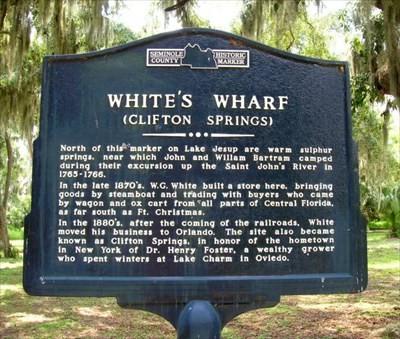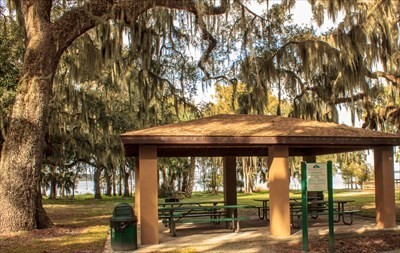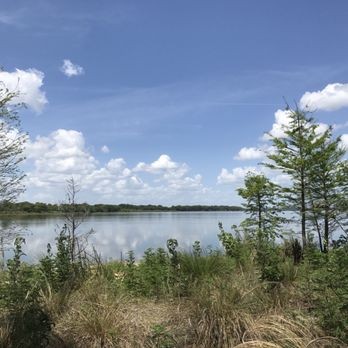White's Wharf (Clifton Springs) (Overlook Park)
Introduction
Text-to-speech Audio
Images
Plaque that greets you as you enter the park

View of the boardwalk jetting out towards Lake Jesup

The Pavillion the shades the picnic tables in the center of the park

View of Lake Jesup from the park

Backstory and Context
Text-to-speech Audio
Description:
Upon driving up to the spring, you drive over a small bridge that goes over one of the springs and then park in one of the six parking spots. At first, you will notice a plaque that gives a short summary of the history that took place at this location. The park is surrounded by two sulfur springs, one to the east and one to the west. You get the feeling as if you are on a small island.
As you walk in, there is a pavilion with several picnic tables. The park itself small but has a large amount of flat open land in the middle of it; perfect for picnics. Throughout the park are large Oak trees covered in moss that provides a shaded canopy from the sun. Around the water’s edge are Cyprus trees with their interconnecting roots, also known as Cyprus knees, that stick up out of the ground. As you look out towards the water, you begin to see a newly reconstructed boardwalk that is usually occupied by local fisherman.
Because this spring sits on Lake Jesup, which has one of the densest alligator populations in the country, you can usually see multiple alligators swimming in the surrounding waters but they keep their distance from the shoreline. On the weekend is when the park gets its most visitors. You can usually see people bring the kids and dogs out to make food on the grills already out there or a couple of fishermen laughing out on the dock. The best time to visit the park is at sunset. Seeing the orange beams of light bounce of the water and scatter through the tangled moss is breathtaking. This park is just another hidden gem unknown to most people in Central Florida.
History:
The swampy shoreline of Lake Jesup near the southern end of the beltway bridge was once the site of at least three wharves and trading posts just after the Civil War. The first time the Springs were discovered was in 1766 when John Bartram and his son William camped there as they followed the St. Johns in search of its source.1
In 1878, W.G. White heard of Bartram’s findings and opened his wharf at Clifton Springs that same year. The Springs were named after the hometown of Henry Foster, a famous northern doctor, who spent many winters at Lake Charm in Oviedo. Soon after, caravans of settlers and traders gathered at the site to stock up on supplies. White employed up to six clerks when new goods arrived by steamer. White also owned a nearby grove that kept his wharf in good supply. Settlers exchanged meat, hides, and plumes from wild birds for flour, grits, cane syrup, molasses, rice, medicines, cloth, and hardware.2
White’s Wharf became an important stop for anyone traveling on the St. John River, as well as the new city of Oviedo. Oviedo historian Richard Adicks adds that the campground at White's Wharf became a community gathering place for church picnics in May, with one Saturday for whites, the next for Blacks. He also states that the Antioch Missionary Baptist Church, founded by a former slave in 1875, held baptisms there. This practice continued until the late 1950s.3
By 1882, White and Foster joined two others, Oviedo postmaster Andrew Aulin and merchant Antonio Solary, who ran a wharf and store near Sweetwater Creek, as partners in the Lake Jesup Steamboat Company. They bought the Isis, a stern-wheeler that hauled fruit across the lake to the St. Johns and north to Jacksonville. This only helped spread the word of White’s Wharf and boosted the popularity of Clifton Springs. However, the following November, the Isis sank in Lake George and three crewmen died. Some say it was caught in a bad storm. Others point a finger at the competing shipping lines in Sanford. This resulted in a complete redesign of the shipping canals around the central Florida area. The Lake Jesup Steamboat Company soon disbanded after the ship was destroyed.4
In the late 1880s, White decided to move his shop over to Orlando as railroads were beginning to be constructed in Central Florida. Since then, the springs have been turned into a city park. White’s Wharf is responsible for supplying thousands of people traveling on the St. Johns River and possibly the growth of the town of Oviedo. Sometime in the early 2000s, Seminole County claimed the land and renamed White's Wharf as "Overlook Park", which they made open to the public during sunlight hours. So, whenever the sun is coming down and you are looking for a place to relax. Stop by Overlook Park to experience a crucial part of Oviedo’s History.5
Sources
- Rover, O. White's Wharf. Waymarking.com. 7/12/2006. 3/25/2019. http://www.waymarking.com/waymarks/WMH53_WHITES_WHARF_Clifton_Springs.
- Robinson, Jim. Around Oviedo. Charleston: Arcadia Publishing, 2012. Print.
- Adicks, Richard. Neely, Donna. Oviedo, Biography of a town. Edition 2nd. S.N, 1979.
- Man, Marker. Florida Historical Markers. Waymarking.com. 12/27/2015. 03/25/2019. http://www.waymarking.com/waymarks/WMQ65C.
- Robinson, Jim. Around Oviedo. Charleston: Arcadia Publishing, 2012. Print.
